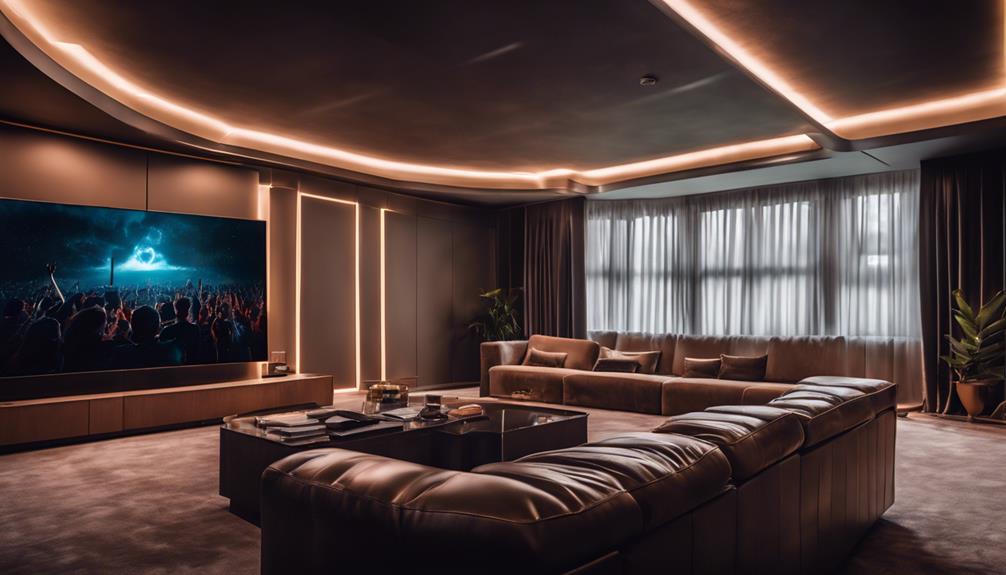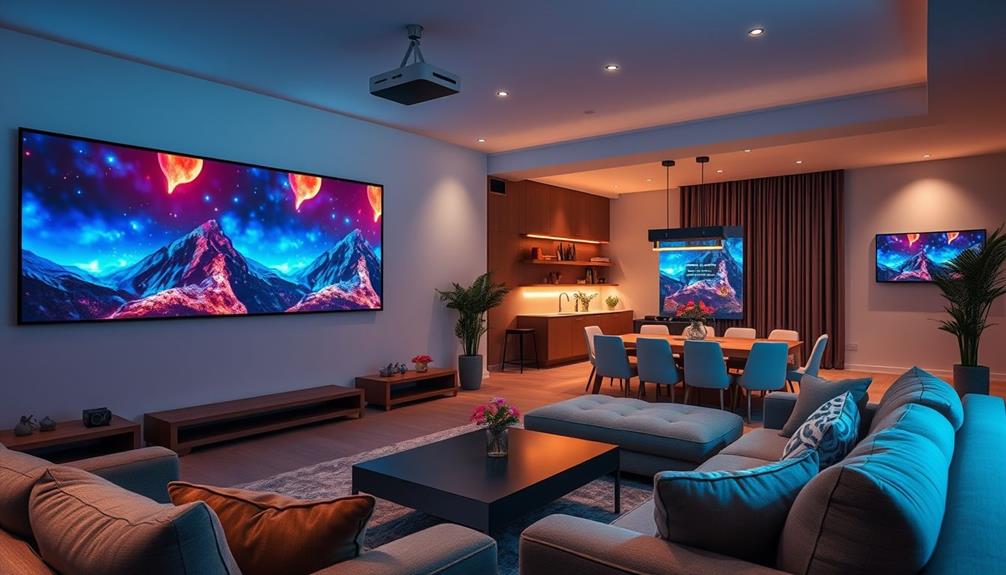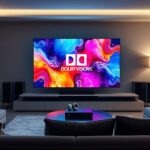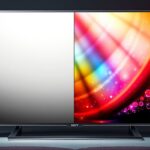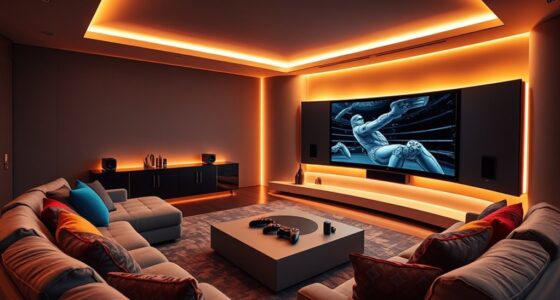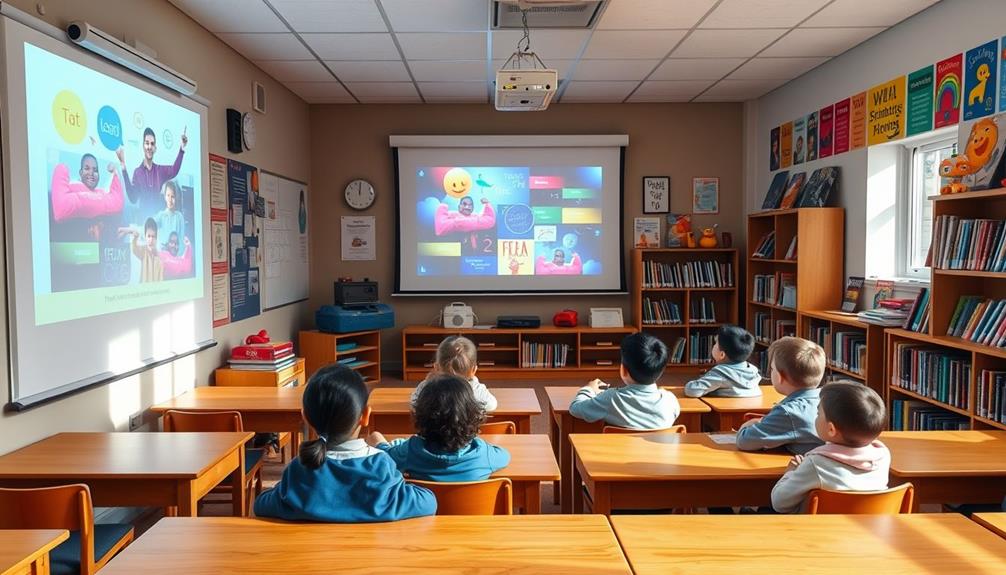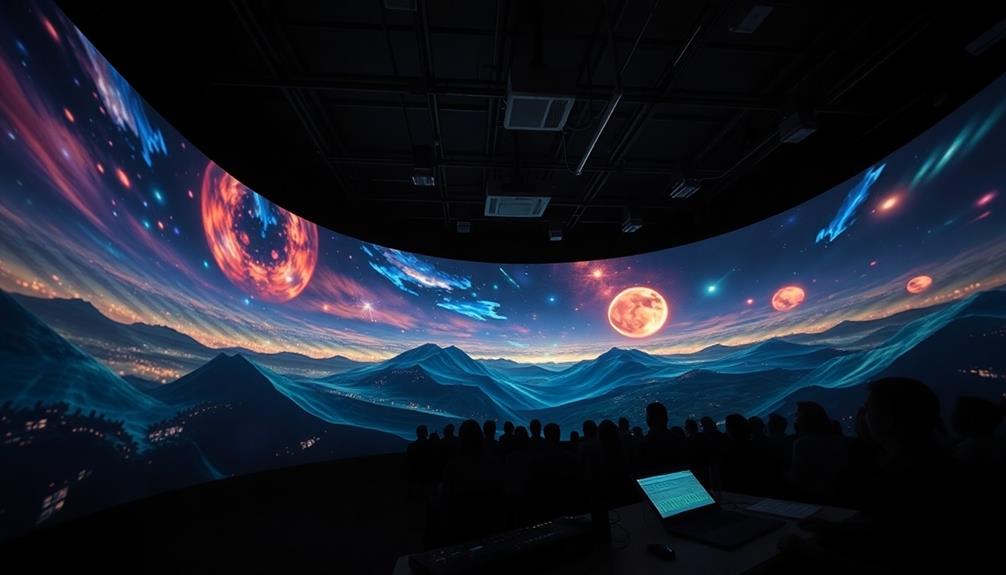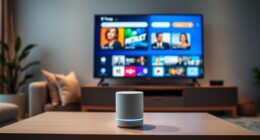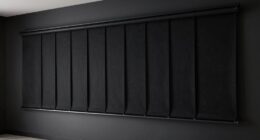To implement Dolby Vision in your home cinema setup, start by confirming that your TV, streaming device, and Blu-ray player support Dolby Vision. Use high-quality HDMI cables rated for 18 Gbps or higher to guarantee proper bandwidth. Connect your devices, enable Dolby Vision in their settings, and check for firmware updates. Stream content labeled as Dolby Vision from services like Netflix or Disney+. Make sure your room is dark to maximize contrast and consider calibrating your display for the best picture quality. Want to fine-tune your setup even more? There's plenty more to discover on optimizing your cinematic experience.
Key Takeaways
- Ensure your display device supports Dolby Vision and use high-quality HDMI cables rated for 18 Gbps or more for optimal performance.
- Connect all source devices, such as streaming devices and Blu-ray players, using HDMI 2.0 or higher to enable Dolby Vision playback.
- Enable Dolby Vision in the device settings and regularly check for firmware updates to maintain compatibility and performance.
- Confirm that streaming services like Netflix and Disney+ offer Dolby Vision content and that your subscription plan includes access to it.
Requirements for Dolby Vision
To enjoy Dolby Vision, you need compatible devices, the right cables, and access to streaming services that offer this enhanced visual experience.
First, verify your TV, streaming device, or gaming console supports Dolby Vision playback. This feature is a must for experiencing the stunning visuals Dolby Vision promises.
Next, use an HDMI 2.0 or higher cable to connect your devices. This is vital, as only HDMI 2.0 or higher can handle the bandwidth required for Dolby Vision content.
After setting up your devices, select a streaming service that provides Dolby Vision content. Popular options include Netflix and Disney+, but check that your subscription plan allows access to this feature.
It's also a good idea to regularly check for firmware updates on your devices. Keeping your devices updated guarantees they've the latest enhancements for Dolby Vision compatibility.
Lastly, refer to the manufacturer's specifications for each device to confirm their support for Dolby Vision and any specific settings you may need to adjust.
Setting Up Your Devices
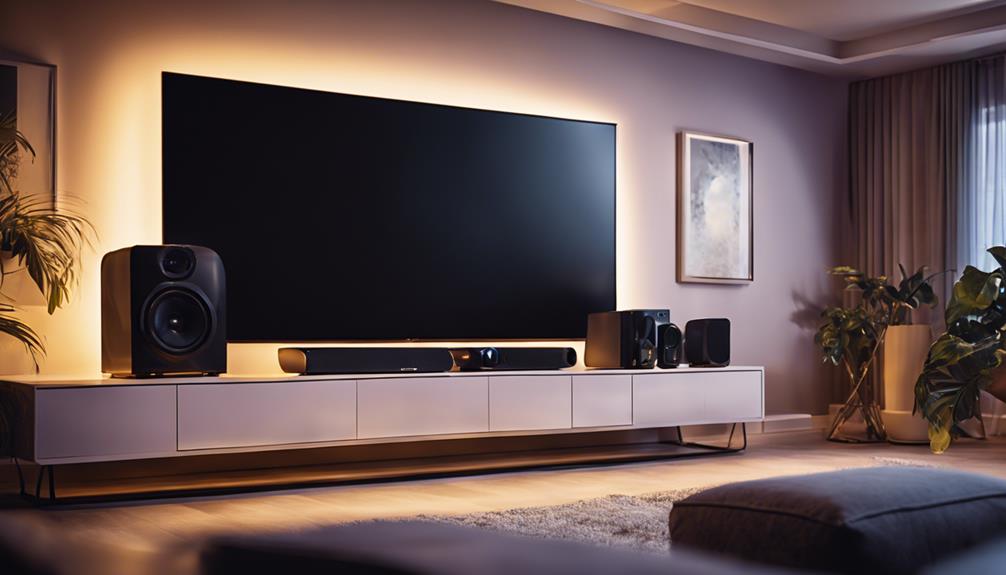
Setting up your devices for Dolby Vision is vital to accessing the stunning visuals that this technology offers. Start by confirming your display device, whether it's a 4K TV or projector, supports Dolby Vision. Look for HDMI 2.0 or higher ports in the manufacturer specifications.
Next, use high-quality HDMI cables to connect your source devices—like streaming devices or Blu-ray players—to your compatible display. This step is critical for maintaining the integrity of Dolby Vision signals.
Then, navigate to the settings menu of your devices to enable Dolby Vision. Toggle on the HDR or Dolby Vision option in the video or display settings if it's available.
Lastly, regularly check for firmware updates to guarantee compatibility and access to the latest features for Dolby Vision playback.
Here's a quick reference table for setting up your devices:
| Step | Action | Purpose |
|---|---|---|
| Check Display | Verify Dolby Vision support | Guarantees compatibility |
| Use HDMI Cables | Connect source devices to display | Maintains signal integrity |
| Enable Dolby Vision | Toggle settings in device menus | Activates Dolby Vision for video and audio |
Checking Content Compatibility
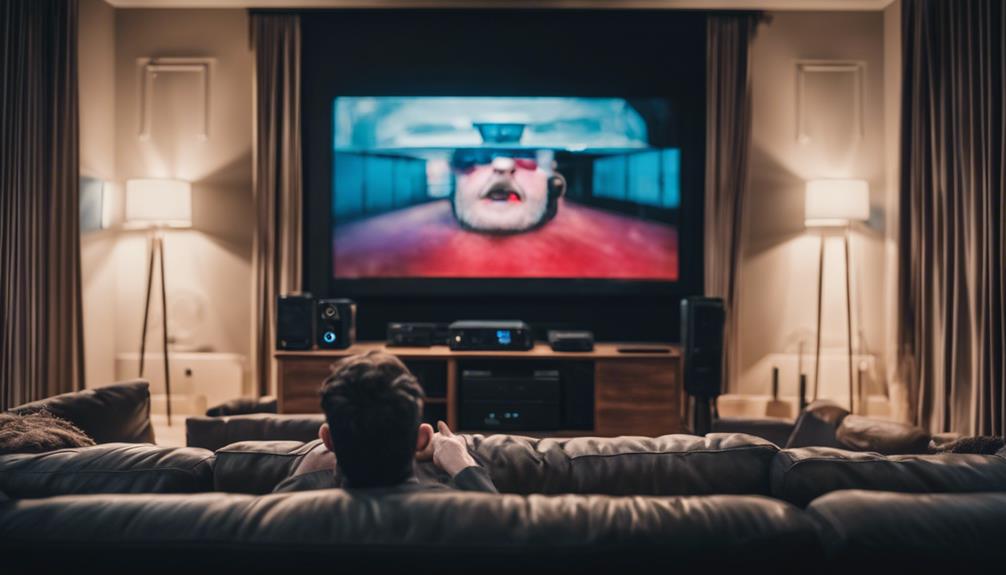
Verifying compatibility with Dolby Vision content is vital for maximizing your viewing experience. Start by checking if the movies or shows you want to watch are labeled as Dolby Vision compatible. Streaming platforms like Netflix and Disney+ often highlight this in the details section, and they typically have dedicated categories for Dolby Vision titles, making it easy for you to find what you're looking for.
If you're using a Blu-ray player, it's important to verify that the Blu-ray discs you own or plan to purchase support Dolby Vision. Not all discs are formatted for this enhanced visual experience, so check the packaging or product details before buying.
Remember that the availability of Dolby Vision content can vary by region and subscription plan. Be certain to verify your streaming service's library to confirm that you have access to supported titles.
Additionally, keeping your subscription updated is a good idea, as regular content library updates can enhance your options, giving you access to the latest Dolby Vision releases.
Troubleshooting Common Issues

Even with compatible content, you might encounter issues while trying to enjoy Dolby Vision, so it's important to know how to troubleshoot common problems effectively.
Start by ensuring all HDMI cables are securely connected and meet the HDMI 2.0 or higher standard, as this is essential for supporting Dolby Vision transmission.
Next, verify that your device settings are correctly configured for HDR or Dolby Vision, and make sure to toggle the feature on if it's available.
If you're still facing issues, check for firmware updates on your devices, including your AV receiver. Installing the latest updates can often resolve compatibility problems with Dolby Vision content.
Additionally, test your setup with different titles known to support Dolby Vision, such as those available on Netflix or Disney+. This helps identify if the problem lies with a specific piece of content.
If issues persist after these steps, don't hesitate to consult the manufacturer's support resources or online forums for troubleshooting advice specific to your device model.
With these strategies, you should be able to resolve most common issues and enjoy your Dolby Vision experience to the fullest.
Enhancing Your Viewing Experience
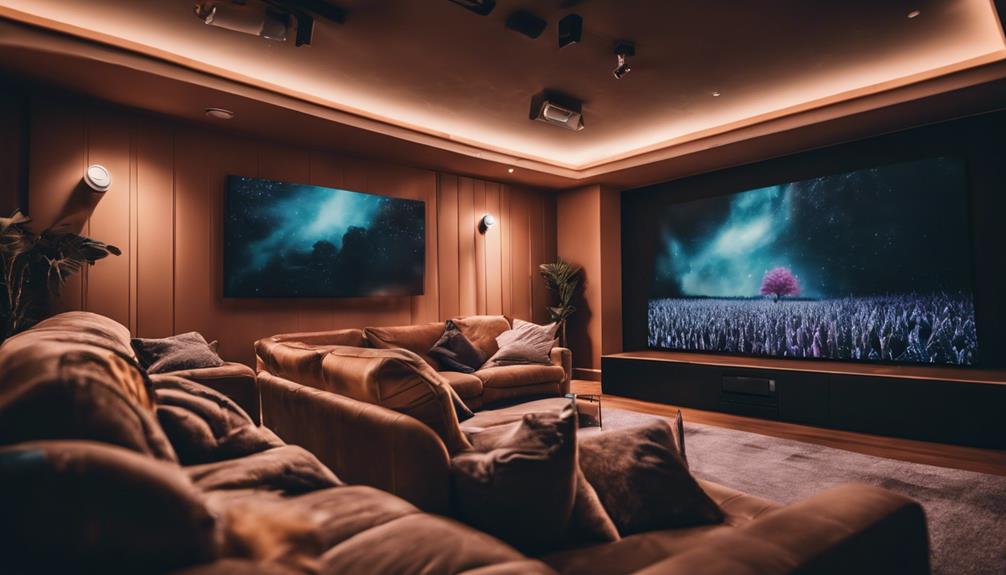
To elevate your Dolby Vision experience, make sure your display and streaming device are properly configured and optimized for HDR playback. First, check that your display device supports Dolby Vision and use HDMI 2.0 or higher cables for the best audio and video quality. Access your streaming device or TV's settings menu and enable the Dolby Vision feature to enhance content playback.
When you're ready to watch, choose content specifically labeled as Dolby Vision from platforms like Netflix and Disney+. These services often have dedicated sections for HDR content, ensuring you get the most out of your setup.
To further enhance your viewing experience, create a dark environment in your room. This will maximize the contrast and color depth benefits that Dolby Vision offers, immersing you deeper into your favorite films and shows.
Lastly, don't forget to regularly check for firmware updates on your devices. These updates can improve compatibility and performance for Dolby Vision playback, ensuring your system remains at its best.
Optimizing Home Theater Equipment
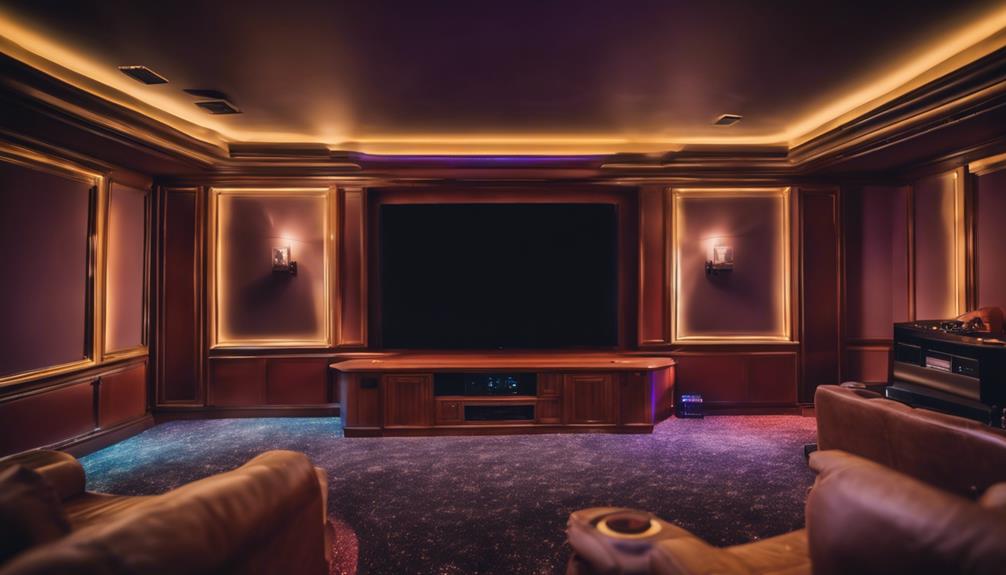
To get the most out of Dolby Vision, you need to guarantee all your equipment is compatible, including your AV receiver and connected devices.
Don't overlook how room acoustics can impact your overall experience; the right setup can make a huge difference.
Equipment Compatibility Considerations
Ensuring your home theater equipment is compatible with Dolby Vision is vital for achieving the best possible viewing experience. You'll want to check that each component in your setup can handle the enhanced features Dolby Vision offers.
Here are some key considerations to keep in mind:
- Make sure your AV receiver supports Dolby Vision and HDMI 2.0 or higher for ideal signal transmission.
- Verify that all connected devices, like streaming players and Blu-ray players, explicitly list Dolby Vision support in their specs.
- Use high-quality HDMI cables rated for 18 Gbps or more to maintain the necessary bandwidth for Dolby Vision content.
Investing in a compatible display is essential, too. Look for one that not only supports Dolby Vision but also boasts good peak brightness and color accuracy.
Room Acoustics Impact
How does the acoustics of your room influence the overall sound quality in your home theater setup? The dimensions of your space play a significant role. Larger rooms may need more speakers and careful placement to achieve peak audio quality.
To enhance your experience, consider incorporating acoustic treatments like sound panels, rugs, and curtains. These elements help reduce echo and sound distortion, creating a clearer audio environment.
You should also avoid clutter and reflective surfaces, as they can muddle sound clarity and disrupt the balance in your audio setup. Proper speaker placement is essential; surround speakers should be at ear level, while ceiling speakers need to be positioned directly above the listening area for the most immersive Atmos experience.
Additionally, don't underestimate the importance of room correction technology in your AV receiver. It can adjust the sound based on your room's unique acoustics, providing a more tailored audio experience.
Frequently Asked Questions
How to Activate Dolby Vision?
To activate Dolby Vision, check your device's compatibility, connect it with an HDMI 2.0 cable, and access the settings. Toggle on the Dolby Vision option, then restart your device to apply changes. Enjoy streaming!
How to Watch Dolby Vision at Home?
Did you know that Dolby Vision can enhance color depth by up to 12 bits? To watch it at home, get a compatible device, stream from supported services, and enable Dolby Vision in your settings.
Does My AV Receiver Need to Support Dolby Vision?
Yes, your AV receiver needs to support Dolby Vision. It must have HDMI 2.0 or higher ports, and you should check if any settings need enabling. Always keep the firmware updated for ideal compatibility.
Can You Get Dolby Cinema at Home?
You won't transform your living room into a Dolby Cinema wonderland, but you can certainly get close! With the right gear and content, you'll create an amazing cinematic experience that'll blow your mind.
Conclusion
Incorporating Dolby Vision into your home cinema is like painting a masterpiece; every detail enhances the overall picture.
By ensuring your devices are compatible and your content shines, you transform your viewing experience into a vibrant tapestry of color and depth.
Don't forget to fine-tune your equipment, as each adjustment is a brushstroke that brings your cinematic vision to life.
Embrace the journey, and soon, your living room will feel like a theater of dreams.
